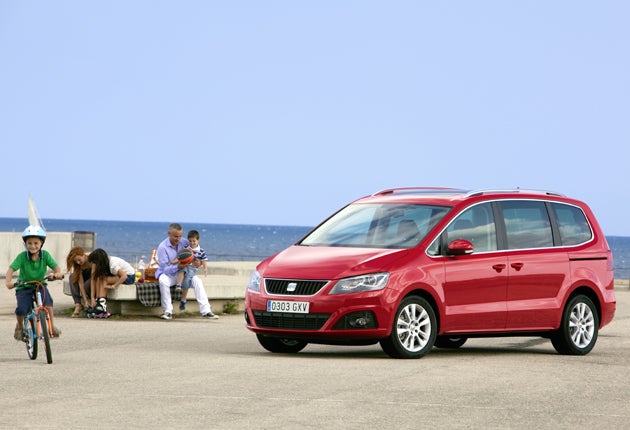Seat Alhambra
Seat's MPV is longer and wider – but it's lighter, good value, and a pleasure to drive

Cars are getting too big. That has long been my mantra, especially regarding width.
Wide cars clog up country lanes and city streets. They overrun spaces in the supermarket car park. By all rational measures, they are a nuisance.
So let's consider the opposing view. Even very wide cars are no wider than, say, a Transit van and there are plenty of those driving around free of opprobrium. (They don't park at Waitrose, though.) A wider car is a roomier car, all the better for the bigger youths who inhabit the planet nowadays. And it's a safer car, because there's more space between the occupants and the car's outer edges.
That's the scene set. Here is the new Seat Alhambra. It's enormous, as enormous as the recently-launched Volkswagen Sharan which we haven't covered in these pages. Nor, now, do we need to because the two cars are almost exactly the same. History is repeating itself here, because the old Alhambra was a lightly remodelled version of the old Sharan and its near-identical twin, the Ford Galaxy.
Some figures. The new Alhambra costs from £21,000, is 22cm longer than the old one, the wheelbase has grown by 8cm and it's a massive 9.2cm – nearly four inches – wider. Despite this, and the full entourage of modern safety equipment, it weighs slightly less than before. That's impressive.
Under the bonnet are the Volkswagen Group's most advanced engines, showing that Seat is no longer restricted to hand-me-downs from the group's German brands. All the quality of fit, finish and tactility trumpeted in the Sharan is carried through to the Alhambra, yet the Seat costs less because it is a "value" brand.
As befits an MPV with nascent minibus tendencies, the Alhambra now has sliding rear side doors. The five rearward seats slide, recline and can be folded completely flat in one easy movement. With all of them so folded, there's a van-like load floor, but even with all seats in use there's decent boot space. The lack of a spare wheel helps here; instead, the tyres use the "ContiSeal" system, an inner coating of flexible, self-sealing polymer able to seal holes in the tread up to 5mm in diameter once you have extracted the offending object.
Children will like the fact that the second-row seats are set higher than the front seats, and the third row is higher again. The middle-row seats can be had with built-in booster cushions which flip up as needed. The sliding doors make all rows easy to reach, and there's the option of electric tailgate-opening for the terminally lazy. Another, worthier, option is a retractable tow-hook which disappears under the rear valance, and you can have a panoramic glass roof.
After the guided tour, the drive. I expected something a little clumsy, and I had mentally placed the Yorkie Bar and The Sun on the dashboard. Expectation denied: the Alhambra proves to be a remarkably lithe drive. It's big and bulky, of course, but it turns smoothly into corners, it hangs on to the road and soaks up bumps beautifully.
Let me qualify that. For suppleness and minimal aural intrusion, you need the 1.4-litre, turbo- and supercharged petrol Alhambra, with 150bhp and a smooth, strong delivery of that power. This lightweight engine allows softer front suspension, hence the smoother ride, and the fact that such a small engine can pull the Alhambra with such spirit is a miracle of downsizing technology. Most buyers, however, will probably choose one of the 2.0-litre turbodiesels, with 140bhp or 170bhp. I tried the latter, with the optional six-speed, double-clutch, paddle-shift gearbox which works well in this application. This Alhambra felt punchier than the 1.4-litre, petrol car, but was noisier and bumpier.
Better to go for the petrol version, then, still low on CO2 and more pleasant to drive. That means very pleasant indeed, and not just by the standards of a minibus. Just don't expect to make any friends in the Waitrose car park.
The Rivals
Ford Galaxy 2.0: from £22,945
Joint class-leader with Alhambra/Sharan, no longer joint venture with VW. Roomy, good to drive, but expensive. No sliding doors.
Peugeot 807 2.0 HDi: from £23,795
Old now but dashboard still futuristic. Roomy, lacks Alhambra's driving appeal, modest pace from 120bhp diesel engine. Has sliding doors.
Renault Grand Espace 2.0: £21,450
Sole petrol-fuelled Espace has 136bhp. No beauty but functional and individual-looking. Comfortable and refined, getting dated now.
Subscribe to Independent Premium to bookmark this article
Want to bookmark your favourite articles and stories to read or reference later? Start your Independent Premium subscription today.

Join our commenting forum
Join thought-provoking conversations, follow other Independent readers and see their replies